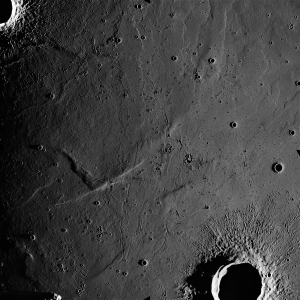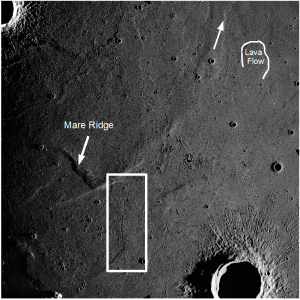
| Project Home | About the Scans | Browse Gallery | Image Map | Support Data | Resources | Ephemeris |
Featured Image - (04/22/2008)
The Complex Lunar Mare
Although the lunar mare look uniform to the naked eye from Earth, the low Sun angle in this close-up photograph shows the complex geomorphological features on this mare surface. Three of the most prominent features are highlighted in Figure 2 (above), and include:
- Multiple lava flows.
Many lava flows can be distinguished in this image. The edges of mare lava flows often have lobate morphology and are sometimes referred to as "lobes." The outline of one of these lobes is shown in the upper right of Figure 2.
All of these lava flows point to the northeast (in the approximate direction of the arrow in the upper right of this image), which indicates that the mare materials that filled this part of the Imbrium basin flowed from the lower left to the upper right.
- Mare ridges, which are caused by the subsidence and contraction of mare lavas.
- Numerous small sinuous rilles that with dendritic branching that resembles the shape of terrestrial rivers. These look very similar to terrestrial rivers formed by the erosion of water. However, these sinuous rilles were actually carved into the lunar surface by very hot and thus very fluid flowing lavas that thermally eroded the lunar surface . Figure 3 shows a close up view of one of these sinuous rilles. Notice how the rille weaves and branches off in different directions.
For more information, please see: Apollo over the Moon: The View from Orbit, H. Masursky, G. Colton, and F. El-Baz, editors, NASA SP-363, United States Government Printing Office, pg. 192. Tweet

|
|
Space Exploration Resources |
|
 LPI LPI
|
Comments and suggestions can be mailed to webmaster@ser.asu.edu


